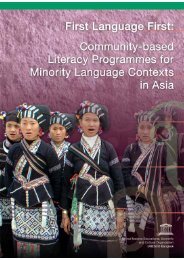Factors to consider in developing MTB MLE curriculum.pdf
Factors to consider in developing MTB MLE curriculum.pdf
Factors to consider in developing MTB MLE curriculum.pdf
You also want an ePaper? Increase the reach of your titles
YUMPU automatically turns print PDFs into web optimized ePapers that Google loves.
Questions <strong>to</strong> <strong>consider</strong> <strong>in</strong> assess<strong>in</strong>g <strong>MTB</strong> <strong>MLE</strong> <strong>curriculum</strong>, teach<strong>in</strong>g and learn<strong>in</strong>g materials. <br />
• In general, are they theoretically sound—based on recognized and accepted theories of <br />
learn<strong>in</strong>g, theories of read<strong>in</strong>g acquisition and theories of language acquisition <br />
• Do they focus on the 3 types of development that are central <strong>to</strong> strong <strong>MTB</strong> <strong>MLE</strong> programs <br />
o Language development: Students are fluent <strong>in</strong> oral and written L1 & LWC and <br />
confident <strong>in</strong> us<strong>in</strong>g both languages for everyday communication and for learn<strong>in</strong>g <strong>in</strong> <br />
school. <br />
o Academic development: Students achieve MOE competencies for each grade and <br />
are confident, successful learners. <br />
o Socio-‐cultural development: Students are proud <strong>to</strong> be both members of their <br />
heritage community and <strong>to</strong> be citizens of the nation. <br />
• Do they encourage students <strong>to</strong> use higher level th<strong>in</strong>k<strong>in</strong>g (focus on mean<strong>in</strong>g) <strong>in</strong> addition <strong>to</strong> <br />
build<strong>in</strong>g their capacity <strong>to</strong> remember and repeat what is taught (focus on accuracy) <br />
• Do they <strong>in</strong>clude a specific (theoretically sound) process for help<strong>in</strong>g students <strong>to</strong> build fluency <br />
and competence <strong>in</strong> us<strong>in</strong>g “everyday” and then “academic” L1 and L2 <br />
• Are they specifically and clearly aligned with MOE competencies <br />
• Do they <strong>in</strong>corporate and build on the knowledge and experiences of the L1 community by <br />
<strong>in</strong>clud<strong>in</strong>g them <strong>in</strong> the activities and materials for each subject <br />
Government <br />
competencies <br />
established for <br />
each grade <br />
and <br />
Knowledge and <br />
experience from <br />
the students’ <br />
home culture <br />
<strong>MTB</strong> <strong>MLE</strong>-‐specific <br />
learn<strong>in</strong>g outcomes <br />
established for <br />
each grade <strong>in</strong> the <br />
program <br />
Indica<strong>to</strong>rs for each <br />
learn<strong>in</strong>g outcome that <br />
focus on mean<strong>in</strong>g <br />
(higher-‐level th<strong>in</strong>k<strong>in</strong>g) <br />
and on accuracy <br />
Lesson plans and <br />
teachers’ guides that <br />
are matched <strong>to</strong> <br />
<strong>in</strong>dica<strong>to</strong>rs and are <br />
‘teacher-‐friendly” <br />
Textbooks and other <br />
learn<strong>in</strong>g materials <br />
matched <strong>to</strong> Outcomes and <br />
Indica<strong>to</strong>rs <br />
2 <br />
Susan Malone, SIL. April 2011
















